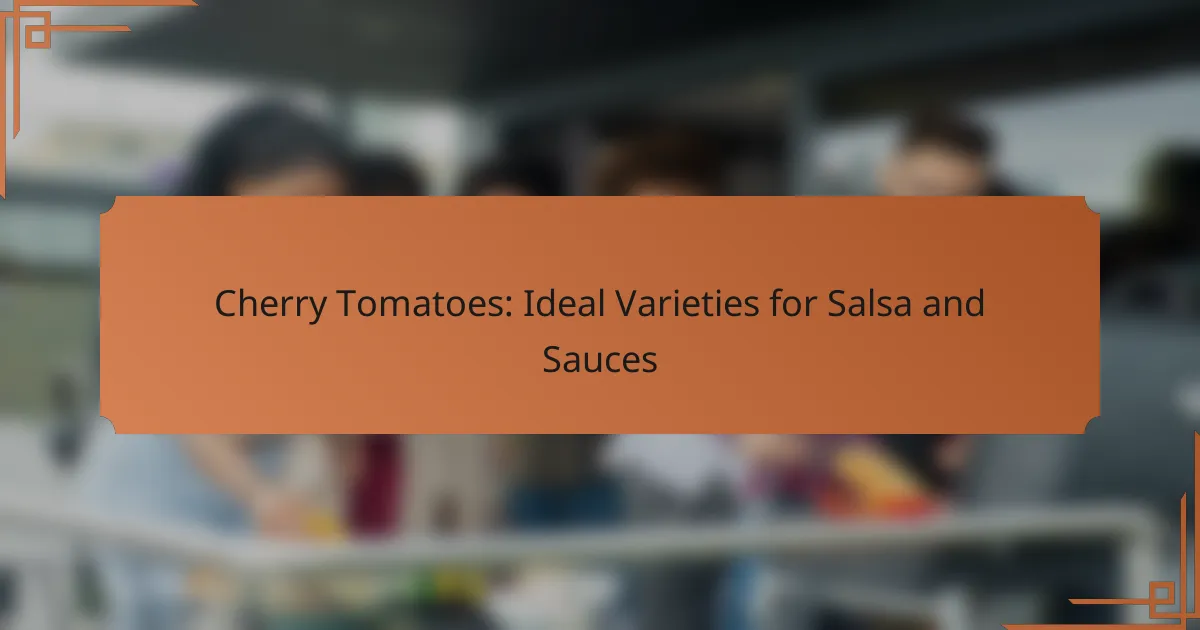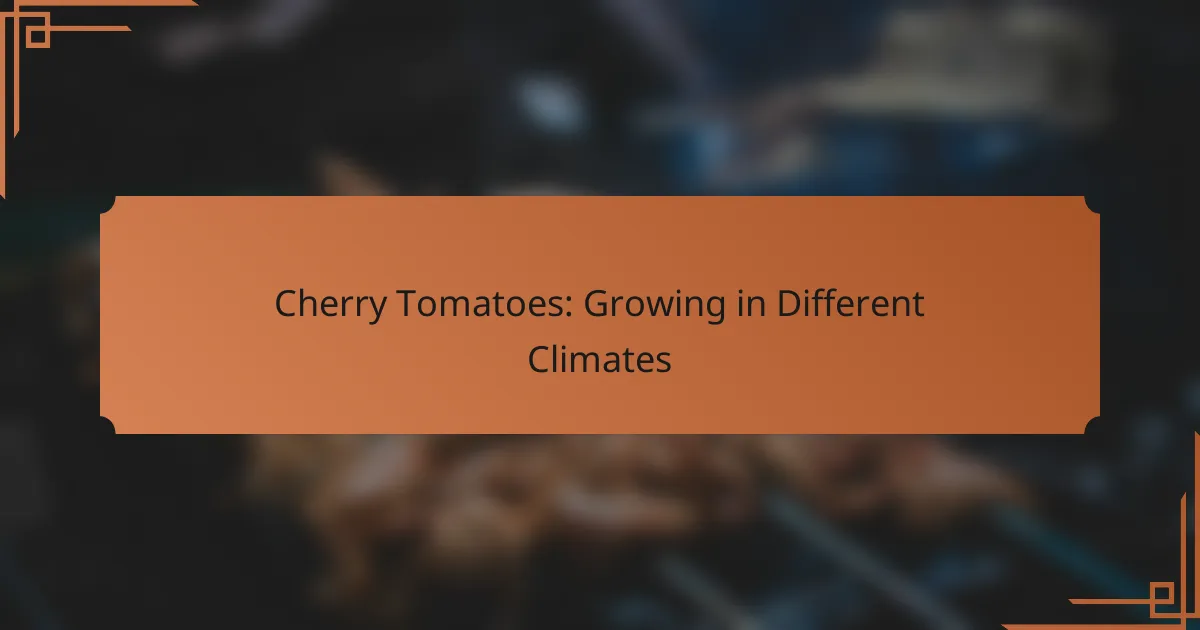Cherry tomatoes are an excellent choice for container gardening, as many varieties are specifically bred to thrive in limited space while delivering a bountiful harvest. When selecting the best types, prioritize compact growth habits and disease resistance to ensure your plants flourish and produce delicious fruit. With the right conditions, including ample sunlight and proper care, you can enjoy a fruitful cherry tomato crop even in small areas.
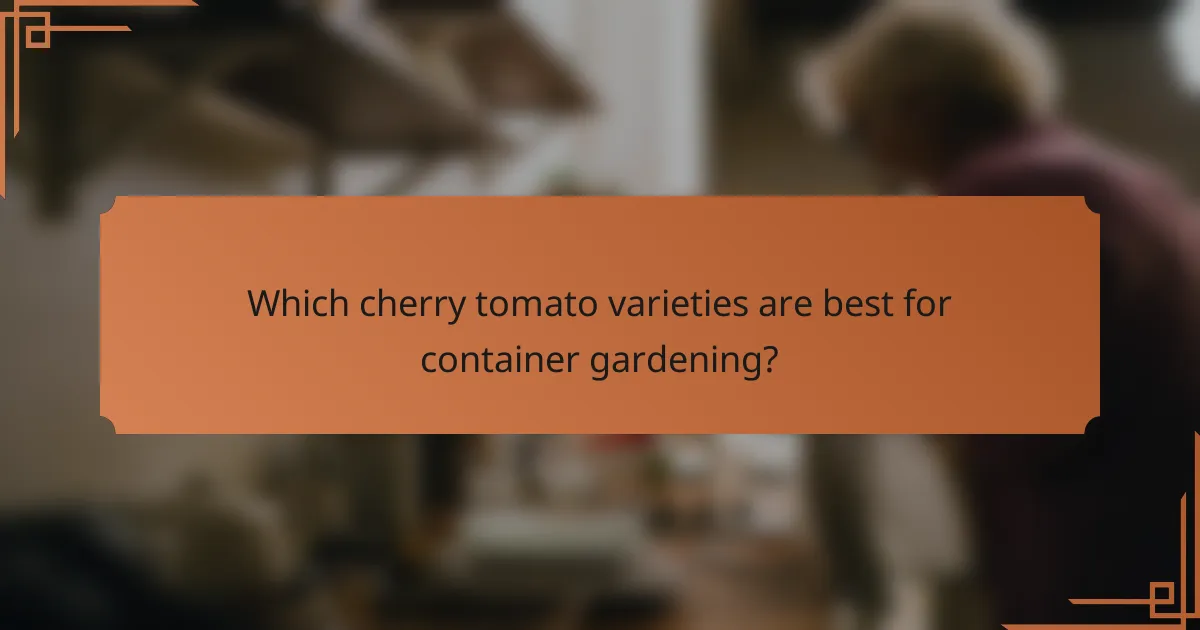
Which cherry tomato varieties are best for container gardening?
For container gardening, the best cherry tomato varieties are those that thrive in limited space and can produce abundant fruit. Look for compact growth habits and good disease resistance to ensure a successful harvest.
Sun Gold
Sun Gold cherry tomatoes are renowned for their sweet, tangy flavor and vibrant orange color. They are indeterminate plants, meaning they continue to grow and produce fruit throughout the season, making them ideal for continuous harvesting.
These tomatoes thrive in containers of at least 5 gallons and require full sun exposure. Regular watering and fertilization will enhance their yield, so consider using a balanced fertilizer every few weeks.
Sweet 100
Sweet 100 cherry tomatoes are a classic choice for container gardening, known for their high sugar content and prolific production. These plants can yield hundreds of small, round tomatoes in a single season.
They prefer a container size of at least 5 gallons and benefit from staking or caging for support. Ensure they receive at least six hours of sunlight daily for optimal growth and flavor.
Patio Princess
Patio Princess is a compact variety specifically bred for container gardening. This determinate plant grows to about 18 inches tall and produces sweet, red tomatoes that are perfect for snacking.
With a container size of 3 to 5 gallons, this variety is perfect for small spaces. Regular watering and a nutrient-rich potting mix will help maximize fruit production.
Balcony
Balcony cherry tomatoes are ideal for limited spaces, such as balconies or small patios. These compact plants grow to about 12 to 18 inches tall and produce small, flavorful tomatoes.
Using a container of at least 2 to 3 gallons, they thrive in full sun and require consistent moisture. This variety is perfect for urban gardeners looking to maximize their yield in tight spaces.
Cherry Falls
Cherry Falls is a unique variety that produces cascading vines, making it perfect for hanging baskets or tall containers. The sweet, red fruits are produced in abundance and are great for snacking or salads.
These plants prefer a container of at least 5 gallons and need full sun. Regular watering is essential, especially in warmer months, to keep the soil consistently moist and promote healthy growth.
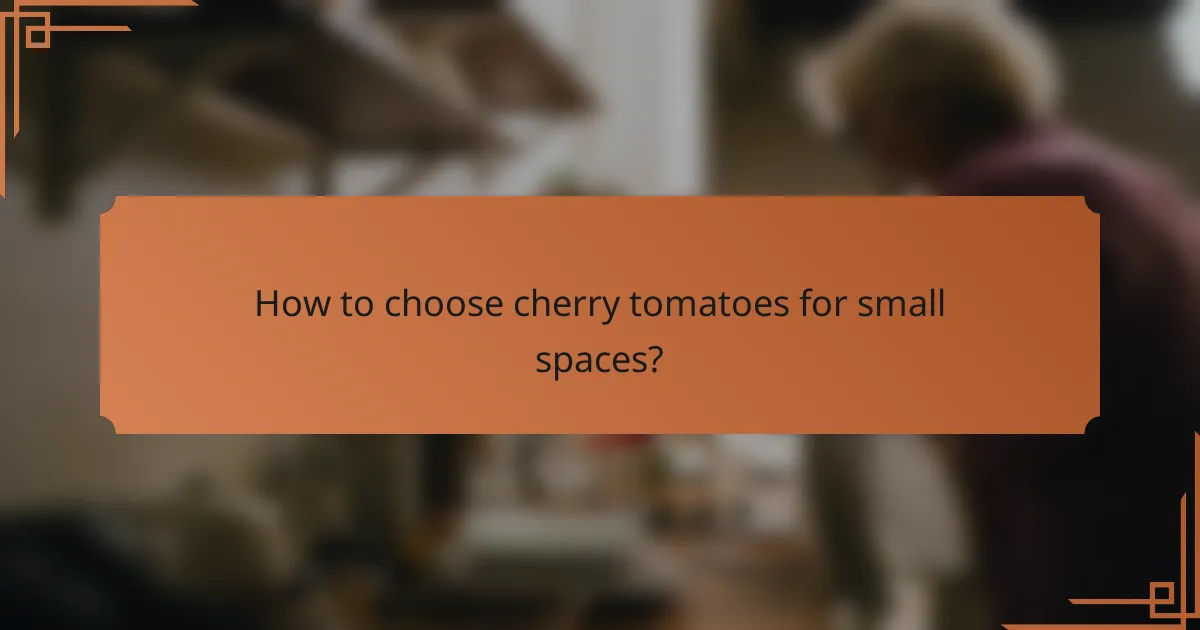
How to choose cherry tomatoes for small spaces?
Choosing cherry tomatoes for small spaces involves selecting varieties that thrive in containers and have manageable growth habits. Look for compact plants that produce abundant fruit while fitting well in limited areas.
Consider growth habit
The growth habit of cherry tomatoes is crucial for container gardening. Determinate varieties, which grow to a certain height and produce fruit all at once, are ideal for small spaces as they require less support and maintenance. Indeterminate types continue to grow and produce throughout the season but may need more space and staking.
Popular determinate varieties include ‘Patio Princess’ and ‘Tiny Tim,’ both known for their compact size and prolific yields. If you prefer indeterminate types, consider ‘Sweet 100’ or ‘Sun Gold,’ which can be trained vertically to save space.
Assess fruit size
Fruit size can impact your gardening experience and culinary uses. Smaller cherry tomatoes, such as ‘Sweet 100’ or ‘Black Cherry,’ are perfect for snacking and salads, while slightly larger varieties like ‘Sun Gold’ offer a sweeter flavor and are great for cooking.
When selecting varieties, consider how you plan to use the tomatoes. If you enjoy fresh eating, opt for smaller fruits that are easy to harvest and eat directly from the plant.
Evaluate disease resistance
Disease resistance is an important factor when choosing cherry tomatoes for container gardening. Look for varieties that are resistant to common issues like blight, wilt, and cracking. Many seed packets will indicate disease resistance, making it easier to choose healthy options.
For instance, ‘Juliet’ is known for its resistance to various diseases and produces a high yield of flavorful fruit. Always check local gardening resources or extension services for recommendations on disease-resistant varieties that perform well in your area.
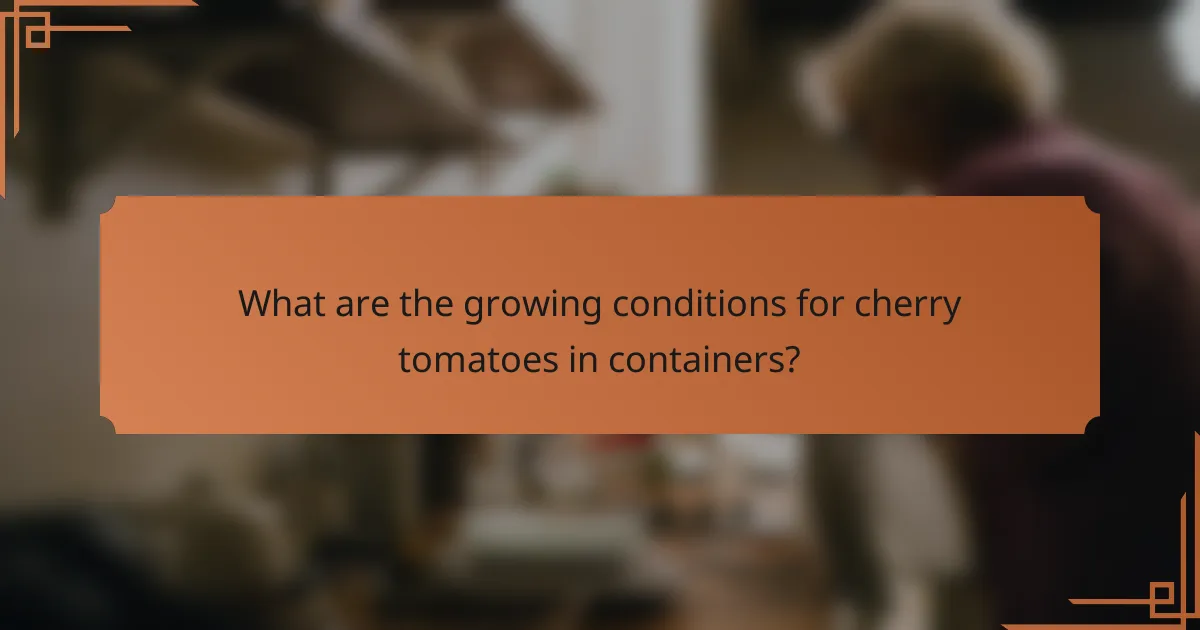
What are the growing conditions for cherry tomatoes in containers?
Cherry tomatoes thrive in containers when provided with the right growing conditions, including adequate sunlight, suitable soil, and proper watering. These factors are crucial for healthy growth and fruit production.
Optimal sunlight requirements
Cherry tomatoes require full sun, meaning they need at least 6 to 8 hours of direct sunlight each day. Position your containers in a location that receives ample sunlight to encourage robust growth and fruiting.
In regions with intense heat, consider providing some afternoon shade to prevent sunburn on the plants. Using reflective surfaces or light-colored containers can also help manage temperature and light exposure.
Soil type and drainage
Using well-draining potting soil is essential for cherry tomatoes in containers. A mix that includes organic matter, such as compost, will enhance nutrient availability and moisture retention.
Ensure that your containers have drainage holes to prevent waterlogging, which can lead to root rot. A layer of gravel or small stones at the bottom of the container can further improve drainage.
Watering frequency
Cherry tomatoes in containers typically need watering every 2 to 3 days, depending on the weather and container size. Monitor the soil moisture; it should be consistently moist but not soggy.
During hot, dry spells, you may need to water daily. Consider using self-watering containers or adding mulch to help retain moisture and reduce the frequency of watering.
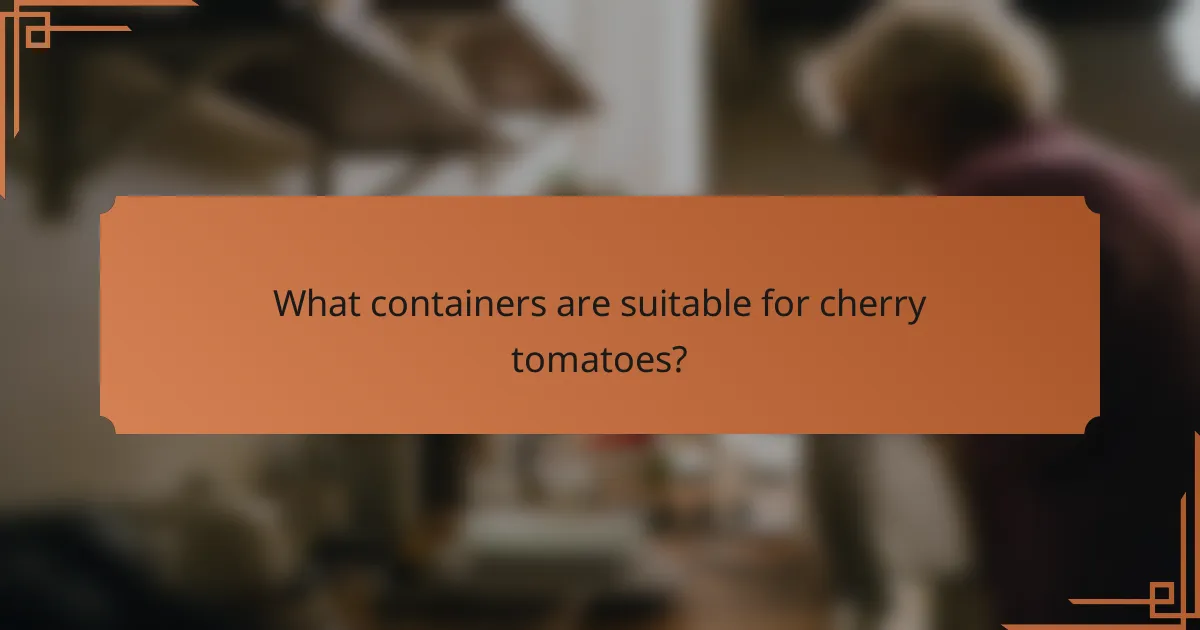
What containers are suitable for cherry tomatoes?
Cherry tomatoes thrive in containers that provide adequate space, drainage, and stability. Ideal containers should be at least 5 gallons in size to accommodate the root system and ensure healthy growth.
Size recommendations
For cherry tomatoes, a container size of 5 to 10 gallons is optimal. This range allows enough room for roots to expand and access nutrients. Smaller containers may restrict growth and lead to poor fruit production.
When selecting a container, consider the variety of cherry tomato. Determinate types may do well in slightly smaller pots, while indeterminate varieties benefit from larger containers to support their sprawling growth.
Material options
Containers can be made from various materials, including plastic, clay, and fabric. Plastic pots are lightweight and retain moisture well, making them a popular choice for many gardeners.
Clay pots offer excellent breathability but can dry out quickly, requiring more frequent watering. Fabric pots are gaining popularity for their ability to promote healthy root growth through air pruning.
Drainage considerations
Proper drainage is crucial for cherry tomatoes to prevent root rot. Ensure that any container you choose has sufficient drainage holes at the bottom. This allows excess water to escape and keeps the soil from becoming waterlogged.
If using containers without drainage holes, consider adding a layer of gravel or stones at the bottom to improve drainage. Regularly check the moisture level of the soil to maintain an ideal balance for your plants.
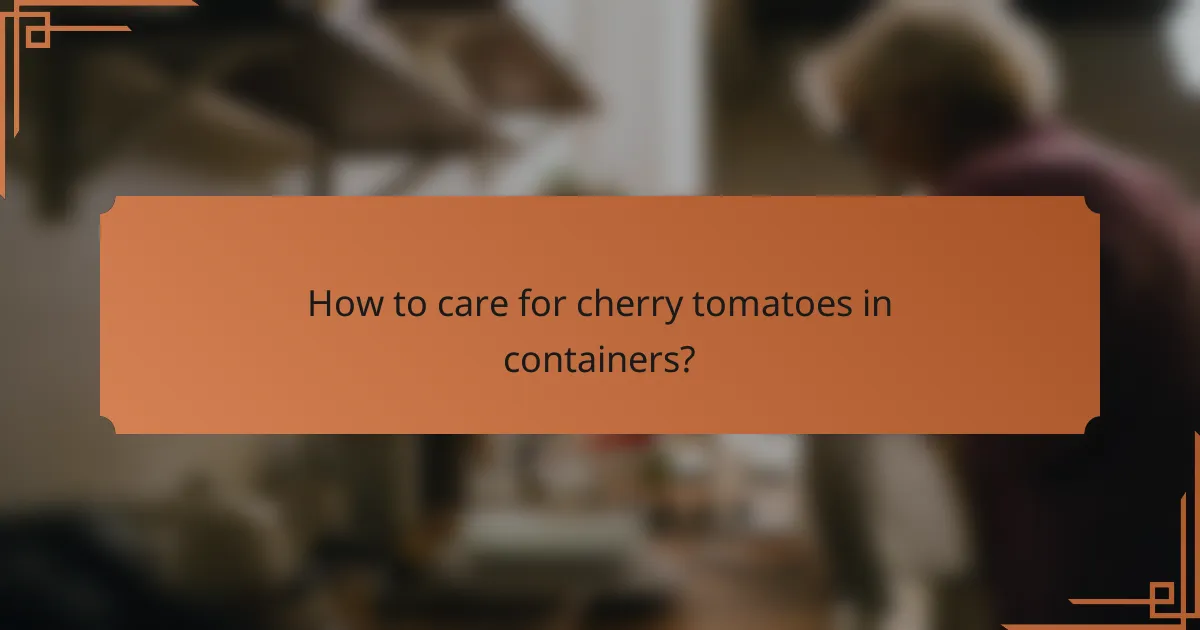
How to care for cherry tomatoes in containers?
Caring for cherry tomatoes in containers involves providing adequate sunlight, water, and nutrients. Ensure the containers have good drainage and use a quality potting mix to support healthy growth.
Fertilization tips
Cherry tomatoes benefit from regular fertilization to promote fruit production. Use a balanced fertilizer with a ratio like 5-10-10, which is higher in phosphorus and potassium, essential for flowering and fruiting.
Apply fertilizer every four to six weeks during the growing season. Be cautious not to over-fertilize, as this can lead to excessive foliage growth at the expense of fruit development.
Pest management strategies
Common pests affecting cherry tomatoes include aphids, spider mites, and whiteflies. Regularly inspect your plants for signs of infestation and consider using insecticidal soap or neem oil as organic treatment options.
Encourage beneficial insects like ladybugs and lacewings, which can help control pest populations naturally. Additionally, maintaining good air circulation and avoiding overcrowding can reduce pest problems.


